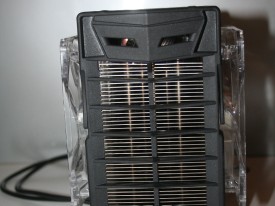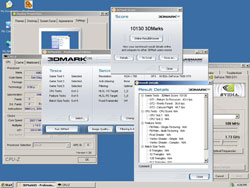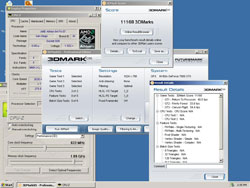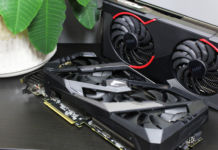NVIDIA has recently launched its new graphic card and despite that we’ve only had the card a few hours we have a short preview of what will come later when the world’s best 3Dmark overclocker is doing his best with it.
After that NVIDIA launched GeForce 7800 GTX in June 2005 it has had all the aces and ATI has been struggling against a too mighty opponent. Like an experienced poker player NVIDIA has made its way to a secure position and from there is has just surveyed the table. It hasn’t been completely passive, which it showed with the lunch of GeForce 7800 GT, but at the same time there has been no need to be all that aggressive as ATI simply has had nothing to match the GeForce 7800-series.
What many has though and ATI feared is that NVIDIA only has been waiting to counter a unavoidable fresh launch by ATI. The launch came in the form of Radeon X1000-family about a month ago but the top model Radeon X1800 XT still hasn’t arrived on the market until a few days back. Since ATI has now claimed the top spot of the graphic card market it is time for NVIDIA to play its trump card, GeForce 7800 GTX 512MB.
Despite that the name of NVIDIA’s new flagship doesn’t indicate much of a difference there is more to it under the hood. GeForce 7800 GTX 512MB os NVIDIA’s 7800-architecture pushed to the limit with just one target in sight, reclaim the crown of performance from ATI and Radeon X1800 XT before they even have had a chance of making themselves comfortable. NVIDIA will sell it new precious at extremely high prices and at very limited quantities so we are really talking about an enthusiast product here. Considering this we have chosen to treat NVIDIA’s graphic circuit as the enthusiast product it is.
Unfortunately we’ve had some problems with the few cards available for testing which resulted in that we didn’t get our card until a few hours before the launch of NVIDIA new graphic circuit, thus this relatively short preview just to give you a hint of what we are working on here at NordicHardware.
We can tell you this much, we’ve put NVIDIA’s hottest graphic card in the hands of Sweden’s two best overclockers, Marcus ”Kinc” Hultin (world record holder in all three 3DMark categories) and Robert ”Crotale” Kihlberg (Swedish champion in processor overclocking 2004). The results of this batch of hardware and knowledge will be presented in a future article here at NH,but before we give a more extensive judgment of NVIDIA’s new flagship we will present some short information about this very card and show you a little of what you can find in our test lab here at NordicHardware at the moment.
Specifications |
|||
| 7800GTX 256 | 7800GTX 512 | X1800XT | |
| Manufacturing name | G70 | G70 | R520 |
| manufacturing process | 110nm | 110nm | 90nm |
| Memory amount | 256MB | 512MB | 512MB |
| Frequency (core) | 425MHz * | 550MHz * | 625MHz |
| Frequency (memory) | 1200MHz * | 1700MHz * | 1500MHz |
| Memory bandwidth | 38,4 GB/s ** | 54,4 GB/s ** | 44,2 GB/s |
| Fill rate | 10,2 GPixel/s | 13,2 GPixel/s ** | 7,1 GPixel/s |
* nVidia reference frequencies, may vary between different cards/manufacturers.
** nVidia reference, depends on frequencies.
With history in mind, this is what we would have expected from an Ultra version, even though the GTX label has been kept this time. Under the HSF (HeatSink and Fan), which has grown to be much bigger, not much have happened since the initial GTX cards. A relatively large increase in clock frequency of both the core and memory has been applied thanks to optimizations of the circuit board and faster memory. A frequency increase of about 30% (or more from some manufacturers) with still using the same manufacturing technology is very impressive and something we’re only use to see in CPUs (Central Processing Units). The HSF as we mentioned in earlier news, is the same as nVidia uses on their Quadro card with multiple large heatpipes.
Now to what we’ve all been waiting for, pictures and performance specs.
The short while we have had the card it has been in the hands of Marcus ”Kinc” Hultin and his world record system which so far only has been cooled with regular air cooling waiting for the extreme overclocking tests. The quick 3Dmark05 benchmark we have run supplies the default values for the cards at stock speed. However XFX’s graphic card is slightly overlocked from factory, performance figures from the regular GeForce 7800 GTX 512MB will be in our big review.
Test system:
AMD Athlon 64 FX-57
DFI LANParty nF4 SLI
Corsair TwinX 2x512MB
OCZ 600W
|
|
Kinc has also done some quick overlocking tsts with air cooling, still a cold one but its still air cooing with the processor working at only 3.0GHz. Without any modification of the graphic card Kinc managed to push the frequencies to scaringly high 633MHz at GPU and 1890MHz memory. this resulted in a very nice increase in performance in 3Dmark05, but this is just the tip of the iceberg as soldering iron and and considerably colder cooling is standing by.
This preview was done in a about an hour and there is still a lot we want to tell you about NVIDIA’s new flagship, but we still have a lot of tests left to do. We will do a full scale review of GeForce 7800 GTX 512MB where you not only will see how the card measures up to to its predecessor, but also ATI’s top of the line Radeon X1800 XT in loads of game tests and similar. Then we will be focusing on the stock frequencies and show you what performance you get for your money if you’re to pay 649 USD for a graphic card.
But as we said earlier, right now the card is in the hands of the world’s leading 3DMark overclockers and together with Sweden’s foremost processor overclockers these two gentlemen have an extreme overclocking article coming where we will see all three top cards battle at the limit of what is possible to push them to with liquid nitrogen in hope for setting new records. Marcus "Kinc" Hultin is a new fellow here at NordicHardware, but Marcus has been showing up a lot lately and those how wants to follow his escapades just have to keep you eyes open for more news, because he is planning something big.
















